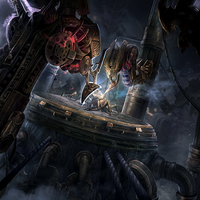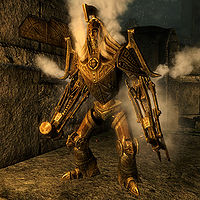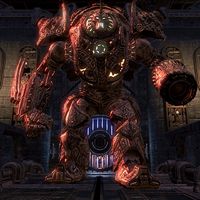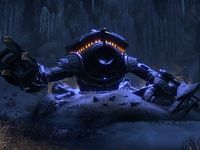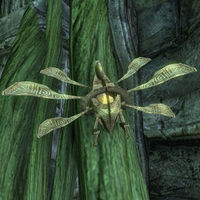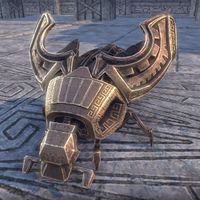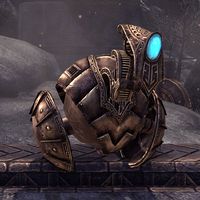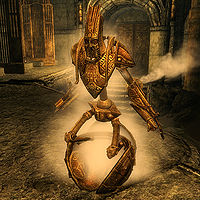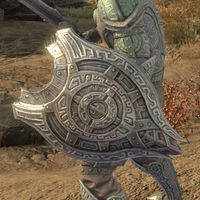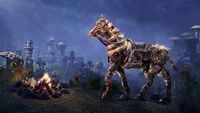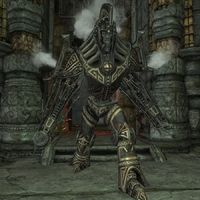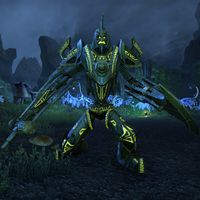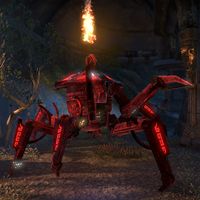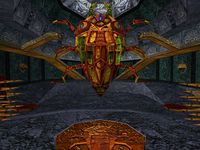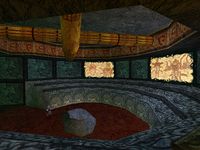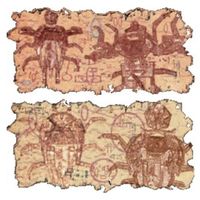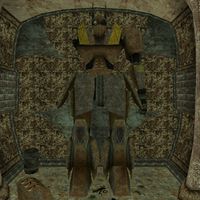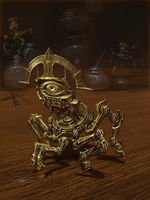Lore:Dwemer Animunculi
Dwemer Animunculi (also known as Dwemer Constructs, Dwarven Automatons, Dwemer Centurions, and Dwarven Robots) are mechanical constructs created by the Dwemer. Made out of Dwarven metal, animunculi were used as war machines and guards. Many of them continue to protect the underground ruins of Dwemer cities long after the disappearance of their creators in 1E 700. They are commonly encountered by scholars and adventurers who venture into the ruins; the animunculi perceive them as invaders, and even worker constructs will attack trespassers on sight.[1]
Dwemer constructs are made with a variety of Dwarven Metals, with Dwarven brass being the most common. Rarer are constructs forged with alloys of Adamant,[2] Glass,[3] and Ebon Steel.[4] Constructs made within the Infernium Forge are especially unusual, and are thought to be crafted by a single Dwarven artisan.[5]
It is inferred from old Chimer stories that the Dwarves had long held the ability to create Animunculi, Chimarvamidium details an era in which Dwemer Animunculi were common and well known to Chimer tribes, but the use of Dwarven Heavy Plate-Mail was new and unknown to them, so much so that a Dwemer in heavy armor could disguise themselves as a Dwemer construct.[6]
Function[edit]
Dwemer animunculi function on steam power, magic and tonal architecture. Constructs around Tamriel, such as in Skyrim and Solstheim, are equipped with individual soul gems or dynamo cores.[7] It is not clear if they are powered directly by the energy of the soul or by some kind of harmonic resonance with the energies contained in the soul gem.[8] [9] Constructs from Vvardenfell that are removed from the region are unable to function in other parts of Tamriel. Returning the animunculus to the region's vicinity somehow restores its functionality.[10]
Research in the Second Era suggested the animunculi found in much of western Tamriel were powered by soul gems. They only deactivated when removed from a ruin as a security measure, but with specialized tools and knowledge it was possible to reprogram them to perform other tasks.[11]
Some researchers, such as Neramo and Aicantar, have managed to control automatons by reverse-engineering and readjusting them. The Tribunal god Sotha Sil was also known to have tinkered with Dwemer constructs, beyond the capabilities of even the most talented individuals.[12][13] His mechanical creations, known as Fabricants and Factotums, are similar, but not considered animunculi.
Some Dwemer animunculi have the interesting ability to power up, emitting a colored glow from the runes engraved on their metal plating that seem to indicate a function. Dwemer Spiders can emit a small electric barrier which they can use to charge up, turning their runes blue. The creation of such a barrier alerts other nearby constructs to absorb power as well. Constructs charged in such a manner can fire off bursts of electricity to attack invaders. When powered constructs are destroyed, they violently explode, releasing their stored electricity.[14] Sometime in 2E 582, Undaunted adventurers journeyed into Darkshade Caverns beneath Deshaan, discovering the Dwemer ruins of Rkugamz. It was guarded by the Sentinel of Rkugamz, which was unique in that it could change color without assistance from other constructs. Its coloration signaled its functions. Green indicated that the Sentinel was calling Dwarven Spiders with regenerative functions, blue signaled that the Guardian was about to fire off electric blasts, and red signaled to the adventurers that the Sentinel was about to spin its blades around wildly in pursuit of its target.[15]
Later that year, the Undaunted explored Rkugamz, where they discovered a Dwemer machine known as the Great Engine with the aid of a member of the Mages Guild. The Engine Guardian, a giant dwarven spider constructed to protect the Great Engine, hindered the Undaunted's efforts to disable the machine so Rkugamz could be explored further. The Engine Guardian shared the Sentinel's lightning-based properties when it glowed blue. However, its functions while glowing red and green differed from the Sentinel of Rkugamz. Instead of providing a means to regenerate itself, the Guardian emitted poisonous gas when it glowed green. Its red glow was a signal that the Engine Guardian had activated fire cannons that were installed below its mantle.[16] The Sentinel of Rkugamz and the Engine Guardian are two notable examples of how the runes engraved on a construct can glow to indicate different functions. While some colors, like blue, can maintain some semblance of uniformity in what they represent, others aren't always as easily predictable.
Not all glowing runes exist to signal that a combative function is being performed. Some construct colors exist for cosmetic purposes. For example, there exists rare ebony constructs which possess a golden double crescent known as a "Solar Arc," which some scholars believe gives tribute to the sun. This iconography isn't seen in many of the Dwemer's other works.[17]
Varieties[edit]
There are many types of animunculi found in Dwemer ruins all over Tamriel.
Architon[edit]
Dwarven Architons are humanoid automatons located in Blackreach, mostly within The Reach. They protect the ancient dwemer ruins. They are imbued with aetherium crystals.[18]
Dynastor[edit]
Dwarven Dynastors (also known as Dwarven Carriers) are massive Dwemer Constructs which resemble horned behemoth-shalks. The Dynastor served as a carriage of sorts. Several Dwarven Spheres were housed in the central carapace. At the appropriate time, they would spring from a concealed chute and presumably operate in tandem to defeat whatever foe they encountered.[19]
Ballistae[edit]
Dwarven Ballistae are animunculi commonly found in Skyrim and Solstheim. They are squat, four-legged constructs and can shoot bolts at enemies for significant, armor-penetrating damage.
Centurion[edit]
Dwarven Centurions (also known as Steam Centurions) are heavily armored constructs with either an extendable mace or hammer on one arm and a spring-loaded blade in the other. Some are able to emit a scalding blast of steam. They are not as common of a sight as lesser constructs in Dwarven ruins. Ruins of Kemel-Ze implies that the centurions have a weakness to frost and magic attacks, due to the steam that drives them, although they are highly resistant against fire, frost, and shock. They are sometimes found attached to a charging gantry when not in use.
While they are typically taller than most men, they can vary in size. Many of the Steam Centurions found in Morrowind are actually shorter than men. A massive version of the centurion, the Dwarven Mechanical Giant, has an extendable mace on one arm. It is very deadly and can only be killed if attacked on its heel. A Mechanical Giant was located in Bthzark, but was defeated by Cyrus in 2E 864 when he attacked its only weak point.
Colossus[edit]
The Dwarven Colossus (or Dwarven Colossi in plural) is a giant automaton of Dwemer design. They are a very powerful, and are larger and more robust than Centurions. They possess blades on one arm and a cannon on the other. They can be found in few dwemer ruins, such as the assembly lines of Bthungthumz.
Delver[edit]
Dwarven Delvers are large machines designed for subterranean excavation. It is believed that in ruins west of Red Mountain, there was a specific threshold to which Dwarven excavators would dig before the construction of vital structures would begin.[20] They are equipped with a laser on one arm and a drill on the other. An inactive one was found in Frostvault and was briefly reactivated to open up door during an excavation.
Drone Fly[edit]
Dwarven Drone Flies are miniature metal insects that can be found in the Dwemer ruins of Vardnknd. They were created for the purpose of protecting against pollen, mold, and disease within the facility. They are designed to follow an individual and aerate nearby spaces, granting resistances to poisons and improving stamina.[21]
Numidium[edit]
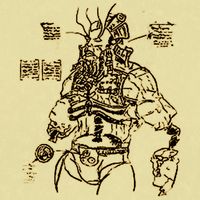
Numidium, also known as Anumidium, Anumidum, the Brass God, the Prime Gestalt, NM, the Brass Tower, Walk-Brass, Big Walker, Walking Star, and the Divine Skin, was a colossal construct of Dwemer origin. It was constructed by Dwemeri Tonal Architect Lord Kagrenac to be a new god, powered by the Heart of Lorkhan, made to retake Resdayn from the Chimer and make the Dwemer race immortal. The Dwemer vanished from Tamriel before the Brass God could be activated, though their disappearance may be directly related to this endeavor.
The Numidium was, in practice, a weapon of devastating power. A "thousand foot tall automaton, a golem or an atronach[nb 1] of sorts", it was used by Emperor Tiber Septim to complete his conquest of Tamriel at the end of the Second Era, but was destroyed afterward. The golem was rebuilt and reactivated centuries later, and became the center of the phenomenon known as the Warp in the West, after which it was destroyed again. Temporal distortions have accompanied each known use of the Numidium, to the point that the Warp in the West is sometimes known as the "Second Numidian Effect".
A second Numidium, Akulakhan, was partially constructed in Morrowind in the late Third Era by Dagoth Ur. However, the destruction of Kagrenac's enchantments on the Heart of Lorkhan in 3E 427 prevented its activation. Akulakhan was based on Numidium's design.
Scarab[edit]
Dwemer Scarabs are animunculi that ressemble organic scarabs that vary in size, with the most notable example being in the Dwemer ruins of Bthzark on Stros M'Kai. Various Dwemer Scarab schematics were discovered in Bthzark, and in Mzuleft, located on the island of Vvardenfell. Many Dwemer Scarabs are present at the Dwarven ruins around the Reach and in Blackreach, and in the Telvanni Peninsula.
Sentry[edit]
Dwarven Sentries (also referred to as Dwarven Theodolites) are spherical animunculi found in Wrothgar, Vvardenfell, and Eastmarch. Sentries patrol ruins in a similar fashion to Dwarven spheres, extending their necks to emit an electrical shock designed to incapacitate intruders. They were primarily used as an automated measuring device designed to explore and survey subterranean areas. They can also generate a barrier to protect nearby animunculi. Sentries have been observed to lock themselves into mechanical frames to become fixed long-range attackers. Although they are robotic in nature, they have been observed to show intelligent movement, as if reacting with emotions.
Sphere[edit]
Dwarven Spheres (also known as Centurion Spheres and Dwarven Centurions) are a common form of Dwemer animunculus that have proven to be agile fighters, and are much stronger than the smaller Dwarven Spider. Dwarven Spheres patrol ruins in a spherical form until they encounter an opponent. At this point, they will emerge from their "shells" to attack.
Dwarven Spheres can be armed with different tools. Some are armed with an extendable sword and a shield, while others, such as the Centurion Archers of Bamz-Amschend, are equipped with crossbows. A specialized version of the sphere known as the Dwarven Arquebus has a lightning cannon in place of blades.
Spider[edit]
Dwarven Spiders (also known as Dwemer Spiders and Centurion Spiders) are small constructs resembling spiders that are very common in Dwemer ruins. They are versatile automatons and perform a variety of functions, such as guarding locations. They can often be found scuttling around ruins, sometimes repairing things. Swarming spiders are present in some ruins, where they burst out of pressure vaults to attack intruders.
Steam Constructor[edit]
The function of the Dwarven Steam Constructor is unknown, but its name implies that it may have been used in aiding Dwemer construction projects. Its appearance is describable as a mashup of various automaton parts, including the legs of a giant Dwarven spider, the upper body of a Dwarven sphere, and various other Dwarven parts mixed in.
Turtle[edit]
Dwarven Turtles function as cargo animunculi. The plastron from the construct's shell can easily be made into excellent shields. Sometime in the mid-First Era, Sotha Sil discovered a storage site containing Dwarven Turtles, and brought in stacks of their parts for use in his creations.[22] A number of Dwarven Turtle plastron shields were notably used by Refabricants, Sotha Sil's proto-factotums constructed from both Dwarven and clockwork parts.[23][24]
Vamidium[edit]
Vamidium is the Dwemeris word for "mount". It is used to refer to the many different types of animunculi constructed by the Dwemer for use as steam-powered mechanical mounts. Many of these constructs were made to imitate nature, taking the form of animals commonly used as mounts by the other races of Tamriel. Like other animunculi, vamidiums appear to utilize soul gems or dynamo cores as a power source.
Notes[edit]
- Dwemer Animunculi were documented within the Infinite Archive in Apocrypha. There, copies of them were subsequently created as maligraphies, creatures composed of vivified ink manifested by stories from books, and serve as mindless extensions of the Daedric Lord Tho'at Replicanum.[25][26][27]
Gallery[edit]
-
A giant, unknown construct in Bamz-Amschend, said to resemble the Numidium.[28]:319
See Also[edit]
Books[edit]
- Dwarven Automatons by Herebane — A guide to Dwemer Constructs
References[edit]
- ^ Hostility of Dwarven constructs towards players and NPCs in Skyrim, Morrowind and ESO
- ^ Adamant Dwarven Horse mount description in ESO
- ^ Vitrine Dwarven Wolf mount description in ESO
- ^ Ebon Steel Dwarven Spider mount description in ESO
- ^ Infernium Dwarven Spider mount description in ESO
- ^ Chimarvamidium - Morabor Sul
- ^ Dwarven construct loot in Skyrim
- ^ Bedyni the Artificer's dialogue during Dissonant Commands in ESO
- ^ Research Notes — Sulla Trebatius
- ^ Senilius' Report — Senilias Cadiusus
- ^ Neramo's dialogue in ESO
- ^ Divayth Fyr's dialogue in ESO: Morrowind
- ^ Appearance of Refabricated Arquebus in ESO
- ^ Combat functions of Dwarven Spiders in ESO
- ^ Sentinel of Rkugamz's appearance and abilities in ESO
- ^ The Engine Guardian's appearance and abilities in ESO
- ^ Solar Arc Dwarven Spider pet description in ESO
- ^ Crafting Motif 96: Arkthzand Armory Style — Mathinn Palard, University of Gwylim
- ^ On Dwarven Dynastors — Raynor Vanos, Scholar of Dwemer Antiquities
- ^ Dwemer Inquiries Vol III — Thelwe Ghelein, Scholar
- ^ Note on the Dwarven Drone Fly
- ^ Crafting Motif 79: Refabricated Style — Dreyla Indavel, Halls of Fabrication
- ^ Factotums found in the Halls of Fabrication in ESO
- ^ The Precursor's dialogue in ESO: Clockwork City
- ^ Loremaster's Archive - Infinite Archive — Master Malkhest
- ^ Master Malkhest's dialogue in ESO: Necrom
- ^ Enemies in Infinite Archive in ESO
- ^ The Morrowind Prophecies: Game of the Year Edition — Peter Olafson
|
||||||||||||||||||||||||||
